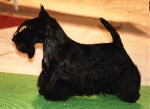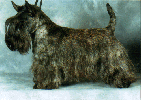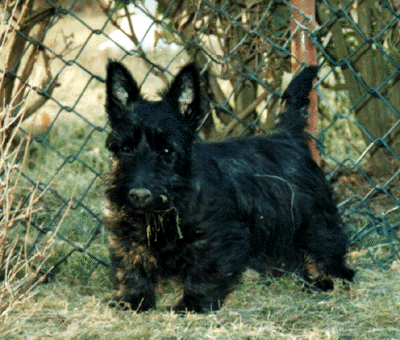|
History
The Scottish Terrier is one of the oldest terrier breeds. First descriptions of a Scottie-like dog
can be found from the beginning of the 19th century but the Scot as we know him today only appeared around
1870-1880. The Scottish Terrier was used in the Highlands of Scotland, in the Blackmoor region, for hunting
badger, fox and other smaller vermin. Strangely enough, it was the English who introduced the breed into
the show world and who pushed the popularity of the breed to unknown heights in the 1930's.
The original sandy and brindle colours were superceded by black at this time and slowly but surely
black became the most popular colour, helped no doubt by the advertising for Black & White Whisky.
After the Second World War, the Scot began to lose popularity, but remains a very well-known breed even today.
Right from the very early years, Scotties were exported to other countries and there is a great Scottie tradition
in America. Breeders in Holland were active at least from the early 1920's - the Breed Club in Holland was founded
in 1925.
Exterieur
The exterieur of the Scot is quite unique, due to his characteristic build, which is
usually accentuated by his trim. Breeders strive for a long head, a short back and short legs.
A type that is small enough to 'go to ground' after his prey, but big enough to stand his ground
against badger and fox. The tail is carried upright or slightly bent over the back, and a long,
harsh outer coat with a softer undercoat gives the Scot a waterproof jacket. A Scot can be any
colour EXCEPT pure white. The most common colours are black, of course, grey brindle, brown brindle
and wheaten. This wheaten colour is very popular in America, and around the 1940's en 50's it was
also quite common in Holland; then it died out, but in the last few years the colour has seen a major resurgence in most
European countries, including Holland.
Character
A Scottie is a brave dog - unafraid and yet reserved, not everybody's friend but totally loyal
to his master. A Scot will often avoid your direct gaze, not even liking you looking at him.
When accustomed to children, they can be excellent playmates, often chasing after a ball or a stick.
However, they are sensitive to harsh words and know exactly when they have done something wrong. Walking
all day or sleeping in the basket - a Scot will adapt and never complains. But a Scot should always show
alertness and should never be afraid.
Special Features
Most people know the Scot as a black coloured dog - never forget that 'a good Scottie never
has a bad colour' - which means that brindles and wheaten coloured Scotties are just as good
as the blacks.
Be careful near water - not all Scotties are good swimmers and you need to supervise them at all times.
Are there pups available at the moment??
Links to Kennel Websites
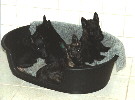 |
 |
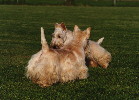 |
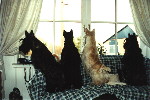 |
Click on the photo for the enlarged view |
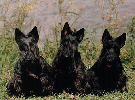 |
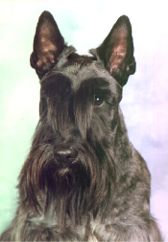 |
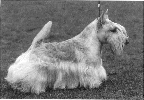 |
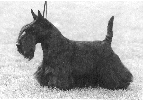 |
|
